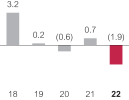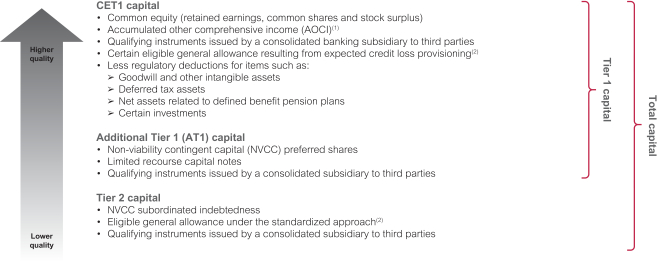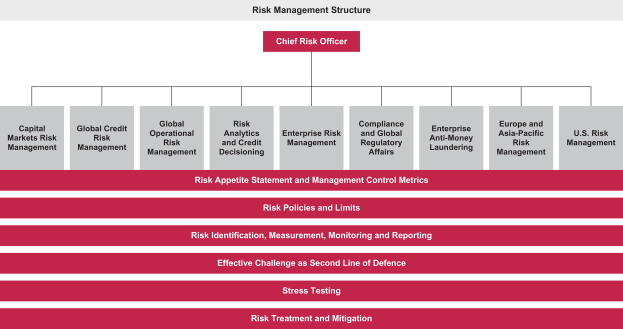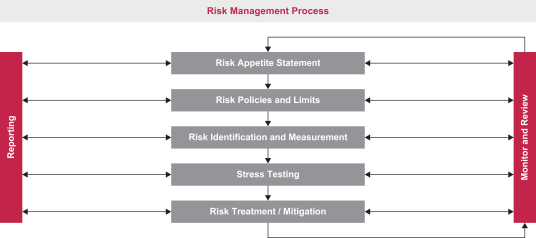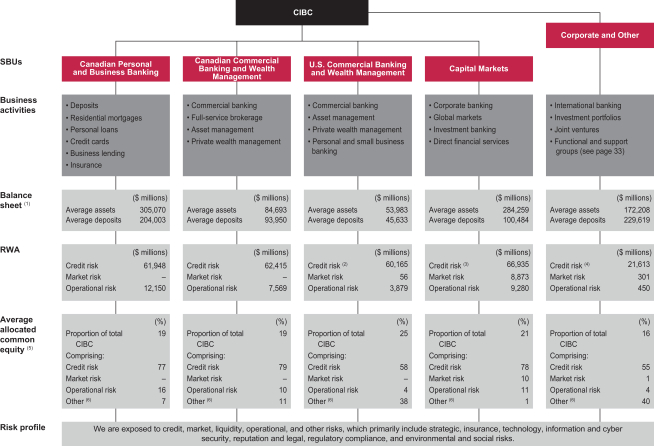|
Management’s discussion and analysis |
As at October 31, 2022, we had goodwill of $5,348 million (2021: $4,954 million). Goodwill is not amortized, but is tested, at least annually, for impairment by comparing the recoverable amount of the cash-generating unit (CGU) to which goodwill has been allocated, with the carrying amount of the CGU including goodwill. Any deficiency is recognized as impairment of goodwill. The recoverable amount of a CGU is defined as the higher of its estimated fair value less cost to sell and its value in use. Goodwill is also required to be tested for impairment whenever there are indicators that it may be impaired.
Estimation of the recoverable amount is an area of significant judgment. Recoverable amounts are estimated using internally developed models that require the use of significant assumptions including forecasted earnings, discount rates, growth rates, forecasted regulatory capital requirements, and price-earnings multiples. Reductions in the estimated recoverable amount could arise from various factors, such as reductions in forecasted cash flows, an increase in the assumed level of required capital, and any adverse changes to the discount rate or terminal growth rates either in isolation or in any combination thereof. Where our estimated recoverable amount is not significantly in excess of the carrying amount of the CGU, additional judgment is required, and reductions in the recoverable amount are more likely to result in an impairment charge.
In the fourth quarter of 2022, we performed our annual impairment test. We concluded that the recoverable amounts of our CGUs were in excess of their carrying amounts.
For additional information, see Note 8 to the consolidated financial statements.
Other intangible assets and long-lived assets
As at October 31, 2022, we had other intangible assets with an indefinite life of $143 million (2021: $140 million) and with a definite life of $358 million (2021: $195 million), including purchased credit card relationships with a carrying value of $218 million (2021: nil) that were acquired as part of the acquisition of the Canadian Costco credit card portfolio. Acquired intangible assets are separately recognized if the benefits of the intangible assets are obtained through contractual or other legal rights, or if the intangible assets can be sold, transferred, licensed, rented, or exchanged. Determining the useful lives of intangible assets requires judgment and fact-based analysis.
Intangible assets with an indefinite life are not amortized but are assessed for impairment by comparing the recoverable amount to the carrying amount. The recoverable amount is defined as the higher of the estimated fair value less cost to sell and value in use. An impairment test is required at least annually, or whenever there are indicators that these assets may be impaired.
Long-lived assets and other identifiable intangible assets with a definite life are amortized over their estimated useful lives. These assets are tested for impairment whenever events or changes in circumstances indicate that the carrying amount is higher than the recoverable amount.
Determining the recoverable amount of intangible assets and long-lived assets is an area of judgment as we estimate the future cash flows expected to result from the use of the asset and, where appropriate, cash flows arising from the asset’s eventual disposition.
For additional information, see Note 8 to the consolidated financial statements.
We are committed to responsible tax practices. We execute active tax governance and tax compliance processes to meet the requirements of tax laws in all countries where we operate. We seek to manage tax and reputational risk to ensure any financial exposure is well understood and remains consistent with our strategy, risk appetite and financial goals.
We are subject to income tax laws in the various jurisdictions where we operate, and the tax laws in those jurisdictions are potentially subject to different interpretations by us and the relevant taxation authority, which gives rise to uncertainty. We use judgment in the estimation of income taxes and deferred tax assets and liabilities. As a result, management judgment is applied in the interpretation of the relevant tax laws and in estimating the provision for current and deferred income taxes. For tax positions where there is uncertainty regarding the ultimate determination of the tax impact, including positions which are under audit, dispute or appeal, we recognize provisions to consider this uncertainty based on our best estimate of the amount expected to be paid based on an assessment of the relevant factors.
Current tax is calculated using tax rates enacted or substantively enacted as at the reporting date. For Canadian income taxes, substantively enacted is generally interpreted to occur at the point of a third reading in a Canadian Parliament held by a minority government, or the first reading in a Canadian Parliament held by a majority government.
Deferred tax assets or liabilities are determined for each temporary difference based on the tax rates that are expected to be in effect in the period that the assets are realized or the liabilities are settled, based on the laws that have been enacted or substantively enacted as at the reporting date.
Deferred tax liabilities are generally recognized for all taxable temporary differences unless the temporary differences relate to our NIFOs and will not reverse in the foreseeable future.
We are required to assess whether it is probable that our deferred tax assets will be realized prior to their expiration and, based on all of the available evidence, determine if any portion of our deferred tax assets should not be recognized. The factors used to assess the probability of realization are based on our past experience of income and capital gains, forecasts of future net income before income taxes, available tax planning strategies that could be implemented to realize the deferred tax assets, and the remaining expiration period of tax loss carryforwards. In addition, for deductible temporary differences arising from our NIFOs, we must consider whether the temporary difference will reverse in the foreseeable future. Although realization is not assured, we believe, based on all of the available evidence, it is probable that the recognized deferred tax assets will be realized. Income tax accounting impacts all of our reporting segments. For further details on our income taxes, see Note 19 to the consolidated financial statements.
Contingent liabilities and provisions
Legal proceedings and other contingencies
In the ordinary course of its business, CIBC is a party to a number of legal proceedings, including regulatory investigations, in which claims for substantial monetary damages are asserted against CIBC and its subsidiaries. Legal provisions are established if, in the opinion of management, it is both probable that an outflow of economic benefits will be required to resolve the matter, and a reliable estimate can be made of the amount of the obligation. If the reliable estimate of probable loss involves a range of potential outcomes within which a specific amount appears to be a better estimate, that amount is accrued. If no specific amount within the range of potential outcomes appears to be a better estimate than any other amount, the
mid-point
in the range is accrued. In some instances, however, it is not possible to determine whether an obligation is probable or to reliably estimate the amount of loss, in which case no accrual can be made.
While there is inherent difficulty in predicting the outcome of legal proceedings, based on current knowledge and in consultation with legal counsel, we do not expect the outcome of these matters, individually or in aggregate, to have a material adverse effect on our consolidated financial



